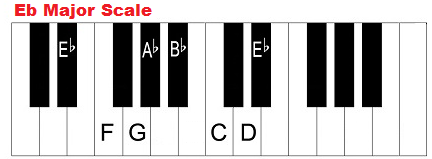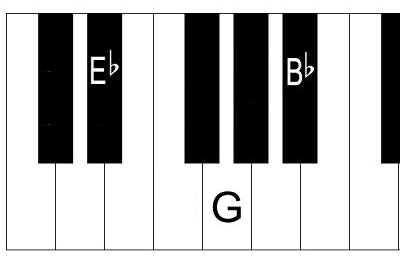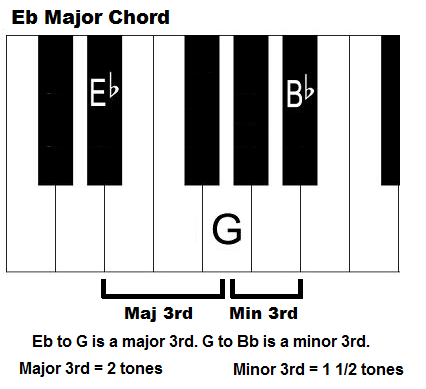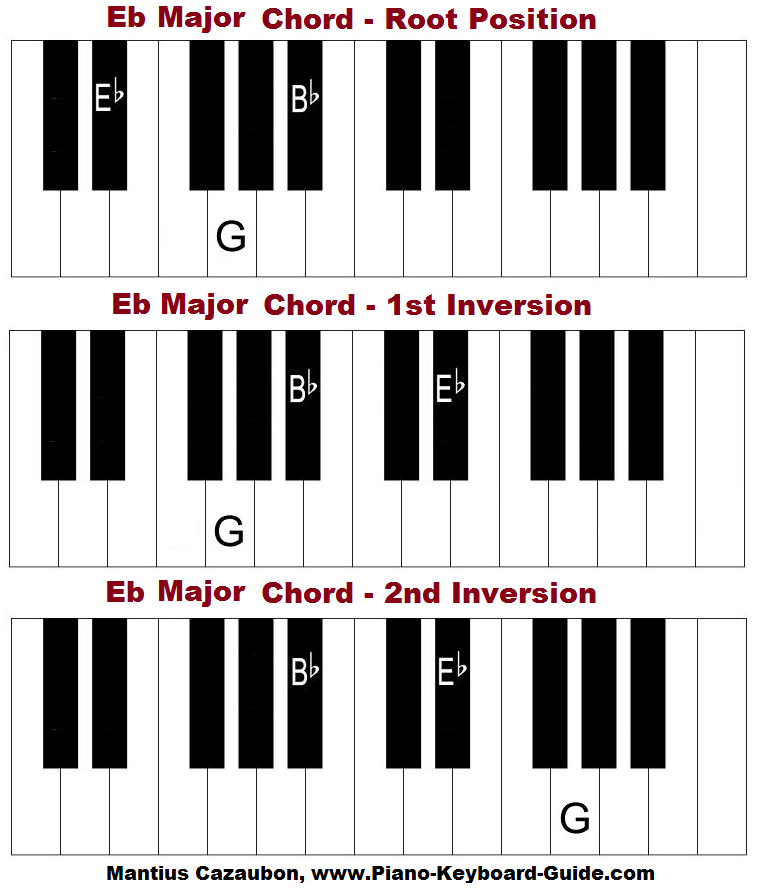Let’s learn how to play an E flat major chord on piano and keyboard. For a better understanding of this chord, let’s first of all take a look at the Eb major scale.
The E Flat Major Scale

The notes of this scale are Eb – F – G – Ab – Bb – C – D. In terms of intervals, Eb is the 1st note or tonic (root) of the major scale. F is the 2nd note or major second. G is the 3rd note of the scale or the major 3rd. Ab is the 4th note or the perfect fourth. Bb is the 5th note or the perfect 5th. C is the 6th note of the E flat major scale or the major 6th. D is the 7th note or the major 7th. And Eb, one octave higher is the perfect 8th.
My Best Recommendation: Click here for the BEST piano/keyboard course I’ve seen on the Internet.
How To Build An E Flat Major Chord
E flat major, like all triads, consists of three notes. This chord is formed by combining the root note, Eb, major third, G and perfect fifth, Bb of the major scale. Eb – G – Bb. In other words, you play notes 1, 3, and 5 of the scale. Play these notes simultaneously and there you have it, an Eb major chord!

Formula of Half Steps – R + 4HS + 3HS
You can form any major chord using a formula of half steps as well. You can do this for E flat major. The formula is R + 4HS + 3HS (root plus 4 half steps + 3 half steps). First of all, locate E flat on you piano keyboard. E flat is the second black key in the set of two black keys on your keyboard. Now that you’ve found E flat, move four half steps to G, then 3 half steps to Bb. In other words, after you find Eb, play the 4th key, G, then the 3rd key after G, Bb.
Build Chord By Skipping Keys
Another way to think of this is to simply play the root note Eb, skip 3 keys and play G, then skip 2 keys and play Bb.
E Flat Major Chord In Root Position and 1st and 2nd Inversions
Until now we’ve looked at the E flat chord only in its root position. We played this chord with Eb in the bottom, G in the middle and Bb at the top. Another way to hold this chord is in its 1st inversion. For the 1st inversion, G is at the bottom, Bb is in the middle and we play Eb at the top, an octave higher. To play the 2nd inversion of this chord, play Bb at the bottom, Eb in the middle and G at the top. The diagram on this page clearly shows the Eb chord in root position, first and second inversions.

Chord Fingering
Let’s now take a look at the fingering of this chord. What fingers play what keys?
Quickly let’s talk about how your fingers are numbered. They are numbered from 1 to 5 with your thumb as finger 1, index finger is finger 2, middle finger is finger 3, ring finger is finger 4 and pinky (little) finger is finger 5.
In root position, the fingering for Ebmaj chord is 1 – 3 – 5. Thumb plays Eb, middle finger plays G and little finger plays Bb.
For the 1st inversion, the fingering is 1 – 2 – 5. Thumb plays G, index finger plays Bb and little finger plays Eb.
For this chord’s 2nd inversion, the fingering is 1 – 3 – 5. Thumb plays Bb, middle finger plays Eb and little finger plays G
Video: How To Play Eb Chord On Piano
Here’s a video showing you how to play the E flat major chord on keyboard and piano.
The relative minor chord for Ebmaj is Cmin. Like every other major chord, its relative minor is based on the 6th note of the major scale.
Be sure to check out the Piano For All piano lessons. It’s my favorite online course for learning how to play piano.